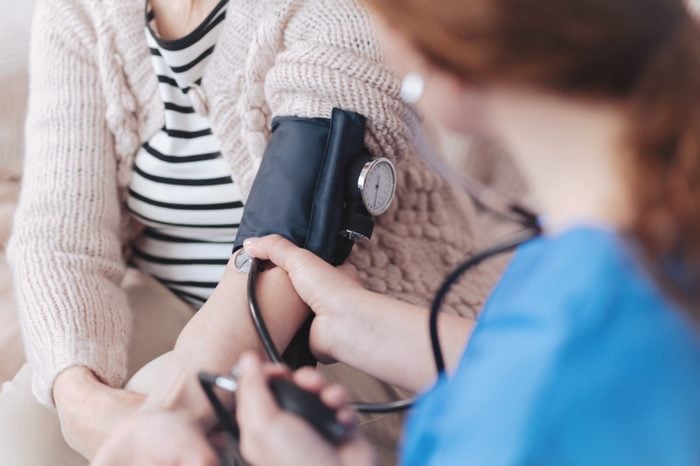
Sepsis symptom: fever
Sepsis strikes more than a million Americans every year, and according to the National Institute of General Medical Sciences, 15 to 30 percent die from it. And yet a survey shows that some 45 percent of Americans have never even heard of sepsis, a deadly infection that happens when the whole body mounts an immune response to an infection elsewhere in the body. People with weakened immune systems are most vulnerable, but anyone can develop sepsis from an initial infection such as pneumonia, a urinary tract infection, or even just a cut on the arm or leg. (Look out for these signs that your cut or scrape is infected.) Although sepsis can easily be treated with antibiotics along with supportive care if caught early, sepsis symptoms can be confused with other conditions, so it often goes undiagnosed until it’s too late. That’s why it’s crucial to learn the signs of sepsis, and the first and most important is a high fever. Sepsis occurs when “toxins from the infecting organism get into the bloodstream and produce inflammation,” says noted sepsis expert R. Philip Dellinger, MD, chair and chief of the department of medicine at Cooper University Health Care in Camden, New Jersey. “Fever is the most specific finding of infection-induced systemic inflammation.”

Sepsis symptom: a very low temperature
Alternately, toxins from a sepsis infection can cause the opposite effect. “Very rarely, the body responds to an infection by dropping body temperature, although this is less common,” says Craig Coopersmith, MD, a surgeon at Emory University School of Medicine in Atlanta and a leading researcher on sepsis. Studies have shown that a low temp can mean a more serious case of sepsis and a worse prognosis. In people who have weakened immune systems, sepsis can sometimes show up without an abnormal temperature.

Sepsis symptom: chills
Ironically, chills often accompany a high temperature—and if this is one of your symptoms, make sure you mention it to the doctor. “Chills are subjective—a patient feels chills but it cannot be observed by a health-care provider,” Dr. Dellinger says. However, fever and chills can easily be mistaken for a different type of infection, such as the flu, so it’s usually only in combination with other symptoms that sepsis can be identified. “The greater the number and magnitude of each finding, the more and more concern there is for sepsis,” Dr. Dellinger says.

Sepsis symptom: pain or discomfort
The pain from fighting off a sepsis infection can be felt all over or localized to specific spots. For 12-year-old Rory Staunton, one of the most obvious sepsis symptoms was pain in his stomach as well as his leg, which was overlooked by doctors. “We made our way to the ER at a major New York medical institution, where the doctors said Rory’s discomfort was caused by a sick stomach and dehydration,” says Orlaith Staunton, Rory’s mother. Sadly, Rory’s sepsis, which he contracted after he cut his arm in gym class, was not caught in time. “The following morning, he continued to complain of pain,” she says. “We brought Rory back to the hospital on Friday evening and this time they admitted him to the ICU. He was gravely ill.” Rory died two days later. His parents established the Rory Staunton Foundation in his memory to promote sepsis education and awareness, for which Staunton was honored by the L’Oréal Paris Women of Worth philanthropic program. Here are 10 more pain symptoms you should never ignore.

Sepsis symptom: low blood pressure
Low blood pressure is “likely the most serious manifestation” of the infection, Dr. Dellinger says, and can indicate septic shock, the most critical stage. Low blood pressure happens during sepsis as blood vessels start to lose fluid and veins and arteries relax, so blood is not moving through the body as it should. “In its most severe form, the low blood pressure does not respond to fluid replacement, and the patient requires medicine delivered into the vein to raise blood pressure,” Dr. Dellinger says. Medical guidelines for sepsis instruct doctors to be on the lookout for a decrease in systolic blood pressure (the top number) to less than 100.

Sepsis symptom: fast heart rate
If you have a sepsis infection, your heart tries to move blood more efficiently so it can fight the illness. “A common response to being sick is for the body to increase the amount of blood being pumped from their heart,” Dr. Coopersmith explains. “The two ways the body has to do this are to increase heart rate and to pump the heart more strongly. This increased blood gives the body a greater chance to fight the infection.” A heart rate of 90 beats a minute or greater may be one of the signs of sepsis, according to the National Center for Biotechnology Information.

Sepsis symptom: shortness of breath
Another hallmark of sepsis that the new guidelines say to watch for is a breathing rate greater than 22 breaths per minute. Sepsis can cause fast breathing for two reasons: “One is that the infection is in the lungs, which causes decreased oxygen,” says Dr. Coopersmith, who was on the task force that developed the guidelines. Pneumonia, which he says is the most common cause of sepsis, is one such infection. But, “even if the infection is not in the lungs, as the infection progresses, the body’s need for oxygen increases and the need to release carbon dioxide increases. The body responds to this by breathing faster and feeling short of breath.” Note that shortness of breath is also one of the silent signs of a heart attack.

Sepsis symptom: pale, mottled, or clammy skin
As your body diverts its energy and resources to the brain and heart, it can start to neglect what it considers less critical organs, like the skin. “When a patient gets septic, the body moves blood flow to the most vital organs and away from parts that are less important to staying alive,” Dr. Coopersmith says. “So it can result in less blood flow to the skin and cause it to be pale.” Orlaith Staunton notes that her son Rory had oddly mottled skin, which was also dismissed by doctors until it was too late. “They were not looking for sepsis and therefore they failed to detect and diagnose it,” she says. “If Rory’s doctors had thought to ask if sepsis could be the reason for his symptoms, they would have seen it immediately.”

Sepsis symptom: sleepiness or mental confusion
Although Dr. Dellinger says this is more common in elderly patients, Orlaith Staunton noticed marked sleepiness in her son, Rory. Just like when you’re tired or when you have a cold, your body needs rest to try to fight off the infection. But Dr. Coopersmith notes that low blood pressure can also make you feel out of it. “When your blood pressure falls below a certain point, you don’t get enough blood flow to your brain, and you can be sleepy or confused,” he says. With sepsis, the sleepy/confused feeling will accompany other characteristic symptoms. Be on the lookout for these other sneaky signs you’re getting sick.

Sepsis symptom: decreased urination
Patients with sepsis start to pee less. This could happen because you eat and drink less when you don’t feel good, or if you’re throwing up or have diarrhea. But it could also be caused by something more serious: “leaky” blood vessels. “Think of blood vessels as being like a garden hose, and millions of small pinholes in a garden hose cause the fluid to leak out” into the body, Dr. Coopersmith says.

Sepsis symptom: nausea, vomiting, and diarrhea
Unfortunately, GI symptoms are what threw off Rory Staunton’s doctors—they thought he just had a stomach virus. Intestinal problems can result from an initial gut infection that leads to sepsis. Or, “as the body moves blood to vital organs, it moves blood away from less vital organs such as the intestines, which can cause some of these symptoms if blood flow is not adequate,” Dr. Coopersmith says. Orlaith Staunton, Rory’s mom, adds, “Some sepsis symptoms are similar to the flu or a virus—a doctor who is not looking for sepsis or is not paying close attention to his or her patient might make this mistake.” This is why New York state passed “Rory’s Regulations” in 2013, to mandate a sepsis protocol for hospitals, which is estimated to save up to 8,000 lives. Illinois followed suit in August 2016. “Hospitals that have implemented strong sepsis protocols have cut sepsis mortality rates by up to 75 percent,” Staunton says. Even so, you can’t assume that medical professionals are infallible or know everything. If you think you or someone in your care might have sepsis, ask the question directly: “Could it be sepsis?” And don’t forget to check out this list of other deadly medical conditions that should be addressed right away.

